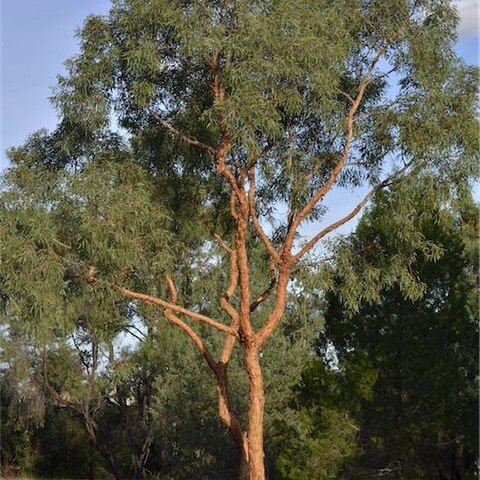Tree to 15 m tall. Forming a lignotuber.Bark rough to the small branches, thick, tessellated and finely flaky, yellow to yellow-brown to yellow-grey.Branchlets smooth (glabrous); have ± elongated oil bodies in the pith.Juvenile growth (coppice or field seedlings to 50 cm): stem rounded to square in cross-section, setose to scabrid until up to ca 0.7 m tall; juvenile leaves opposite for only 1 or 2 nodes then alternate, always petiolate, ± orbicular to ovate or deltoid, 6.5–16.5 cm long, 2.5–7 cm wide, base peltate (until ca 0.7–0.9 m tall then the bases rounded), apex blunt or pointed, green, scabrid with the weathered remains of bristle-glands until ca 0.8–1 m tall then glabrous. Crown entirely of glabrous Adult leaves; leaves alternate (occasional pairs sub-opposite), petiole 1–3.6 cm long; lanceolate or falcate, (8)10.5–24.5 cm long, 1–3.8(4.8) cm wide, flat, base tapering to petiole, apex finely pointed, margin entire, concolorous, dull or slightly glossy, green to grey-green, penniveined, densely to very densely reticulate, intramarginal vein parallel to and just within margin, oil glands island, small, numerous.Inflorescence terminal compound, peduncles 0.6–2.5 cm long, buds 7 per umbel, sessile or shortly pedicellate (pedicels to 0.4 cm long). Mature buds obovoid, 0.6–0.9 cm long, 0.5–0.6 cm wide, white on surface due to rubbery cuticle (not wax), scar present (outer operculum shed early), operculum flattened to rounded and umbonate, or conical, sometimes wider than the base of the bud, stamens inflexed, anthers ± oblong, versatile, dorsifixed, dehiscing by longitudinal slits (non-confluent), style long, stigma tapered, locules 3, the ovules arranged in 5, 6 or 7 ± vertical rows on the placentae. Flowers white.Fruit sessile or shortly pedicellate (pedicels 0–0.4 cm long), barrel-shaped to urceolate or truncate-globose, 0.8–1.5 cm long, 0.7–1.3 cm wide, disc descending, valves 3, enclosed.Seeds brown to reddish brown and shiny, 3–6 mm long, boat-shaped with a keel on the smooth and usually cracked dorsal surface, not winged but some seed have a short flange at one end, hilum ventral. Cultivated seedlings (measured at ca node 10): cotyledons reniform to orbicular; stems usually rounded in cross-section, setose throughout; leaves always petiolate (1.5–2.3 cm), opposite for at least 12 nodes or for only 2 to 5 nodes, then becoming alternate (but may revert to opposite for several nodes higher up stem), ovate to lanceolate, 8–18.5 cm long, 2.5–7.3 cm wide, base rounded until node 3 to 5 then peltate for many nodes, margin entire, apex pointed, dull, green, setose on both sides.
More
Bark tessellated on trunk and larger branches. Juvenile leaves broadly lanceolate. Adult leaves lanceolate, thick; lamina 12–20 cm long, 2–4 cm wide, shining, green; lateral veins fine, at 60°–70°; intramarginal vein up to 1 mm from margin; petiole flattened, 16–22 mm long. Peduncle ribbed, 10–17 mm long. Operculum conical or hemispherical-conical, c. 3 mm long, 4–6 mm wide; hypanthium conical or hemispherical, 5–7 mm long and wide.


